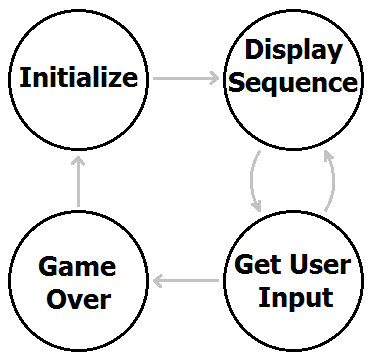The logic of a Simon game is quite simple. It should save a random sequence of LEDs to light, each round appended with another random LED value.
After appending it, the new sequence should be displayed to the user, and then wait for the user to click the buttons in corresponding order. If the user succeeds in doing so, the random list increments and the show goes on the same way. But if he fails in doing so, then he has lost - the game should be abruptly stopped with some visual signal, the random list is shorted to 1 value and the game begins from zero.
The basic implementation I thought of has these 4 states, each has it's special functionality:

There only seem to be 3 variables necessary - The length of the random list, the current index of the user in that list, and the random list itself.
The first one, which I have called V_LED_MAX, is really the score of the player. The second, which I called V_LED_CNT, is an auxiliary variable used to pass on the random list.
Though using jumps in the end of each state, I ended up making each state a function, called from a main switch-case that is the state machine. A new variable called V_STATE was added to store the state.
Looking at it now, using this state machine isn't really adding anything useful apart from making the state machine explicit rather than implicit, hiding at jumps in the code. But given that it's a very simple state machine, and given that V_STATE is updated before ret commands anyhow... meh, it could have been just jumps.
Anyway, I'll present some assembly code of Semyon in the next log.
 HummusPrince
HummusPrince
Discussions
Become a Hackaday.io Member
Create an account to leave a comment. Already have an account? Log In.